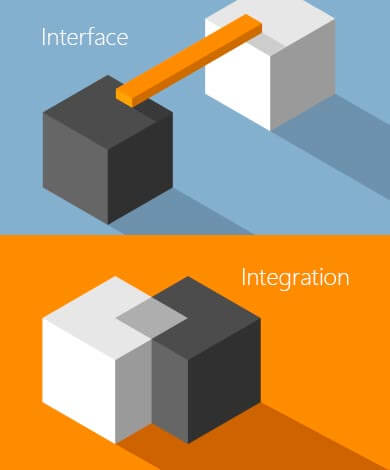Interface vs Integration: Which is the Right One for You
Interface vs Integration: Which is the Right One for You
Sometimes it feels annoying to live in society where everything is categorized neatly into different fields. Of course you will acquire more accurate information, but only if you manage to go past the intricate lexicons of jargon. Some of them seem so similar yet contrast so profoundly. What we are discussing today is one vivid example: integrate vs interface, what are their differences?
First we need to know why these two words would be confused, except for the same spelling starting with an ‘inte’. Most fundamentally, both words describe the process of linking two independent systems, and hence the basic difference lies in how the link is established. For interface, it stresses the link itself rather than the two components, just like a bridge between two banks of a river. An interface only serves as a channel for exchange without affecting the independent operations of the two systems. On the other hand, integration emphasizes the concept of one unity consisting of two different system, which work together sharing the same resources and platform.
 When applied to business scenarios, the two concepts and demonstrated more vividly. For instance, a graphical user interface (GUI) in a customer relationship management (CRM) system allows sales personnel to input customer data, view customer interactions, and generate sales reports. Integration may come with more diverse forms, including the combination of inventory and e-commerce platforms.
When applied to business scenarios, the two concepts and demonstrated more vividly. For instance, a graphical user interface (GUI) in a customer relationship management (CRM) system allows sales personnel to input customer data, view customer interactions, and generate sales reports. Integration may come with more diverse forms, including the combination of inventory and e-commerce platforms.

Integrate vs Interface: Choosing the Right Approach
After understanding the distinctions between interface and integration, you will find that they are actually not that similar but instead, implemented in different ways. Interfaces are primarily designed for users, and hence will take intuitiveness, ease to use and elements that elevates users’ experience into consideration. Integration, on the contrary, targets mostly back-end developers for the sake of seamless data exchange, so more effort will be required to achieve the optimal synergies.
Choosing between interface and integration depends on the specific needs and goals of the business. If real-time data sharing and synchronization are crucial, integration may be the better choice, as it allows data to be updated in real-time across all applications, reducing errors and ensuring consistency. On the other hand, if flexibility and the ability to connect various programs from different vendors are more important, an interface might be the more suitable option, as it allows for simpler replacement of individual software products.
Next time you come across a dilemma between interface and integration, don’t flinch at their seemingly identical appearance. Understand your needs before making the final decision that may possibly help achieve a productive technological landscape in your company.
Related:
- The 3 Biggest Challenges for the Aftermarket
- Challenges I See the Industry Facing
- Ten Tips to Find the Best Office Printer
Comment:
Please leave your comment below about the article: Interface vs Integration: Which is the Right One for You.








Leave a Comment
Want to join the discussion?Feel free to contribute!